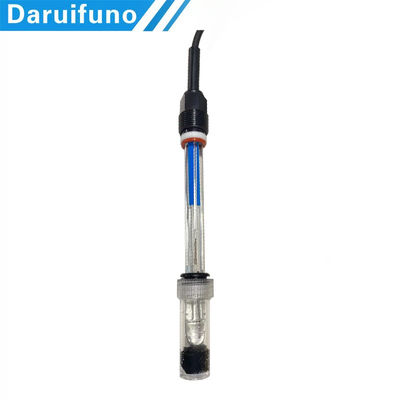0~135℃ High Temperature Resistance Glass PH Probe For Dirty Water
The pH electrode is the part that responds directly to the pH in the solution. It consists of a glass rod and a glass hydrogen ion sensitive membrane. When the sensitive film comes into contact with an aqueous solution, a gel layer forms on the outside. At the same time, since the inside of the electrode is filled with aqueous electrolyte solution, there is also a layer of gel inside the membrane.
The hydrogen ions in and around the gel layer will seep out or penetrate into the gel layer depending on the concentration of hydrogen ions in the test solution, that is, the pH. If the solution is alkaline, H+ will seep out and a negative charge will form outside the membrane. Since the electrolyte inside the glass electrode has a constant pH value, the potential on the inner surface of the membrane remains constant during the measurement. As a result, the internal and external charges of the pH electrode are different.
Specification:
| Product Name |
pH sensor |
| Product Model |
ASP201 |
| pH Range |
0~14pH |
| Resolution |
0.01pH |
| Shaft Material |
Glass |
| Working TEMP |
0~135℃
Medium and low temperature environment:0.0~80℃ (sustainable work)
High temperature environment: 80-135.0°C (each continuous work does not exceed 60 minutes)
|
| Reference System |
double salt bridge |
| Reference Electrode |
Ag/AgCl |
| Electrolyte |
Gel |
| Working Pressure |
0~4Bar (When at 135 ℃) |
| Temperature Unit |
Vacant/NTC10K /PT1000 (optional) |
| Membrane |
Porous |
| Glass Head |
Transparent low impedance |
| Dimension |
Diameter: 12mm Length:120mm |
| Thread Size |
PG13.5 |
| Lead Wire |
Standard 5m |
| Ground |
—— |
| Cleaning |
—— |
| Application |
Dirty water |
Please click the catalog of pH controller here:
Daruifuno Catalog.pdf
Brief introduction:
-
Glass shell pH composite electrode;
-
Blue low impedance hemispherical glass head, high strength, not easy to break
-
The reference is ceramic hole shape core, it has the characteristics of smooth response, no potential drift and good stability;
-
The reference system is Ag/AgCl, double salt bridgefilled with KCl colorless high temperature gel;
-
The reference electrolyte is saturated KCL+ excess KCL crystal, the service life is long;
-
The ASP101 pH electrode can not only be used for drinking water but also in wastewater, sewage and other industria applications.

Aplication: water monitoring
Drinking water,surface water,water quality analyze,ground water,ect.
Industrial process monitoring and dosing control
Chemical,petroleum,paper,food and medicine,PCB manufacturing,etc.
FAQ
1. What is themeasurement principle of this pH electrode?
A: The pH value potentiometric method uses the potential difference of glass electrodes for pH measurement.
2. How is this glass pH electrode composed?
A: The pH electrode is usually composed of an indicator electrode and a reference electrode.
3. How to judge the pH of the solution?
A: If the internal hydrogen ion concentration of the pH glass bulb is lower than the outside, the measured solution is recorded as acidic and the pH value is lower than 7; if the two are the same, the solution is neutral and the pH value is equal to 7; if the internal hydrogen ion concentration is higher than externally, the measured solution is alkaline and the pH value is higher than 7
4. What is the wire length of the pH electrode?
A: The lead wire of this electrode is 3m by default, other lengths need to be customized, contact our customer service, the price will vary with the change of length.
5. How often must the pH sensor be calibrated?
A: Depends on the type of sample:
Dirty samples and non-aqueous samples require more frequent calibration.
Depends on the required accuracy:
For very accurate measurements, at least daily calibration is required.
Depends on the quality of the electrode:
Old electrodes require more frequent calibration.

 Your message must be between 20-3,000 characters!
Your message must be between 20-3,000 characters! Please check your E-mail!
Please check your E-mail!  Your message must be between 20-3,000 characters!
Your message must be between 20-3,000 characters! Please check your E-mail!
Please check your E-mail! 





